This week I had the privilege of spending Monday, Tuesday, and Wednesday at the largest dairy conference in New Zealand. It took place on the campus of Lincoln University and it was great to be back there again after three years. The conference had a great line up of speakers; the Deputy Prime Minister of New Zealand, The coach of the New Zealand All Blacks Rugby Team (He is more popular than the Prime Minister!), an entrepreneur and franchisor who was a high powered speaker, and some of the top leaders in the dairy industry, just to name a few. I enjoyed talking to vendors at the trade show to learn about a vast line up of products for the dairy grazing systems. I also got to meet a lot of new people. One young farmer who was from Ireland I got to know quite well along with some very good farm consultants. Overall I can't even begin to count the number I people I met and talked with. Most of the educational sessions were very good as well and the format for the whole conference made it flow very smoothly. I am so glad I attended this event and feel very blessed at having the chance to go.
Yesterday was quite an exciting day! I got the privilege of working a cattle yard for the first time. We had 5 vets out to the runoff block yesterday to teat seal the heifers (160 of them). This involved us getting the whole herd of heifers out of their paddock and a half a kilometer to the cattle yard. Then we drafted out the heifers five at a time to push up a shoot onto a portable stand where the vets did the teat sealing. It involved swinging many gates around and just moving cattle where they didn't want to go. It took us about four hours to finish the herd but it went pretty smoothly after we got our rhythm down.
I also got to watch dogs herd the hefiers out of the paddock which is really neat to see, I wish I would have videoed it. It was a beautiful day to do the work yesterday, it was sunny and about 60 degrees, with clear skies that revealed snow covered mountains, you can't beat that! Not anything to earth shattering to report (except for the two earthquakes we had last night). Yesterday I gave my first injection to a cow. The heifer that we have been milking has a Retained Placenta, so she has been a bit sick. I haven't given to many injections during my time on dairies before so Steph walked me through it to give the heifer a shot of Penicillin in the muscle. It went pretty good (the heifer might think differently) and she is starting to perk up a bit now. When we give injections on the farm we use the MRS T rule of thumb; Mark the animal, Record the treatment, Separate out of the mob of cows, and then Treat her. This process helps to protect against a treated cow getting milked into the tank.
The majority of the last two days has been filled with many odd jobs around the farm. Yesterday all four of us filled 4 out of the 5 calf sheds with sawdust and fix up the gates in preparation for calving. Today I picked up a lot of rubbish around the buildings and in the yards, cleaned up the shop area, and scrubbed down equipment in the milking shed. Thats about the extent to what has been happening on the farm this week. So Saturday I convinced Brittany to come to the run-off farm to take pictures of how we feed the cows in the winter. So here is a bunch of the pictures from that day. Here is a video that Brittany took of me moving the break-fence up. Enjoy! I did some more new jobs today and yesterday on the farm. It started out with milking my first cow on the farm since we got here. That's right, out of 800 cows we are milking a grand total of 1 cow. I used a bucket milker to get the job done. It is quick and only requires cleaning in the milker that I used instead of the whole entire milking system.
After that I started putting up a new fence in the center of the farm in an area that we will graze the few bulls we will have on the farm later in the year. I used 3 different types of posts; a Waritar which is a triangular metal post, a standard wood post, and fiberglass rods with an funny looking clip on them. I strung up "spider" wire in all the posts, which is a very thin wire. I think I could still use a little improvement on attaching insulators to the Waritars but other than that I think I did alright. I had the unique opportunity to today to take part in the behind the scenes discussions about how to fine tune the system and improve on the previous season. It started out with the farm's advisor going over the financials and the goals we have set for the coming season. After that we met with two vets to discuss animal health issues. Then we had lunch and met with the fertilizer rep to go over agronomy plans for the farm, and during that we had a pretty good sized earthquake, but not quite big enough to stop the discussions. Finally we met with the breeding specialists to go over AI plans for the season. It was interesting to see and discuss pretty much every major aspect of the farm in the same day. I really appreciate Andy involving me and the rest of the staff in these bigger management discussions.
Today it rained most of the day so things got a bit slimmy. I spent most of the day at the run-off block again apart from a short time that I was hosing down cement pads around the milking shed. After lunch we (Steph, Russ, and I) had to chase around hefiers that got out into the kale at the run-off block.
I learned a little bit about nitrate posioning in cows today. It can occur a lot when cows are grazing brassicas or a fleshy crop like sugarbeets, when the weather is very overcast and rainy. This is because the plant takes up nitrate from the soil but the plant cannot photosynthesis very well because of the lack of sunlight. It also can occur when there is frost on the plants or if its growing extremely fast. The signs that we look for in a cow that has nitrate posioning is if she has a hard time standing and getting up. Also I believe if there is milk leaking that can be a sign. It needs to be treated quickly because a cow can die very quickly if not treated for it, but once treated they usually bounce back very very quickly. We treat the cows that show signs of nitrate poisoning with a shot of calcium in the vein and phosphate in between the ribs. Thats the main thing that I learned about today, and I have off until Monday now. Today was my first day of working on the farm. The day mostly consisted of feeding cows at the run-off block, which is where the cows all go for the winter. The cattle graze kale and sugarbeets and we also feed them baleage and straw in bale feeders. Feeding the baleage and straw keeps the cows gut healthier and it is safer on the cow than just letting her fill up on kale. Break fences are setup and moved twice daily about 7 meters at a time (depends how many cows are in the paddock). This allows the cows to graze just the face of the crop so it is utilized better. I had great time of work, getting to know the cows, the farm, and my fellow team members; Russ, Eugene, and Steph. I am sure I will learn a lot from them all!
|
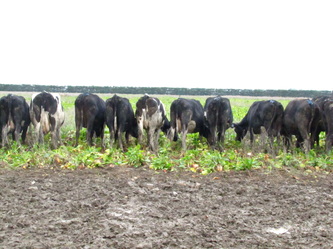
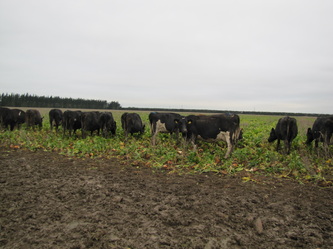
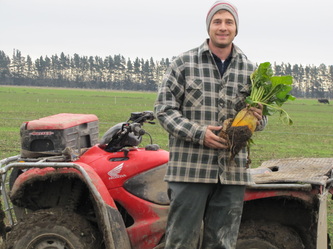
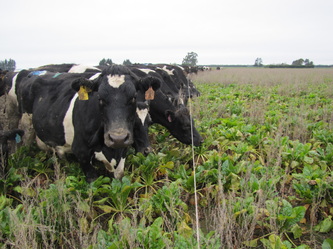
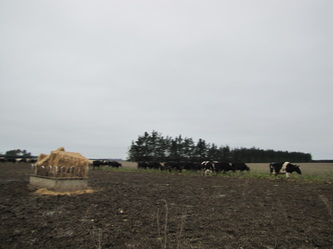
 RSS Feed
RSS Feed